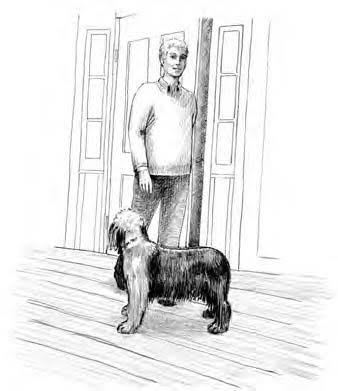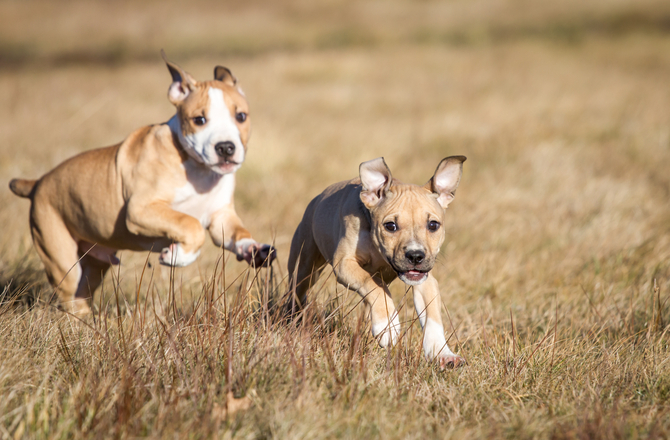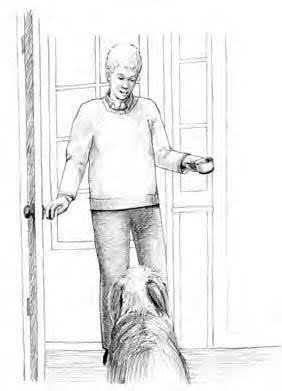In This Chapter
- Knowing how to react to a barker
- Controlling a puppy who digs
- Admonishing mounting
- Resolving separation anxiety
- Building a timid puppy’s confidence
Watching your household and yard get reconfigured by the paws of your puppy is never fun. But, before you set out to admonish her, you need to spend some time discovering the reasons prompting her reactions. For example, a puppy who shreds pillows when you leave, only to quake and look guilty when you return, doesn’t have supernatural human powers — in other words, she doesn’t know any better. But, if you dig deeper, you’ll find that she’s likely experiencing separation anxiety, which is something that will only increase if you have an exaggerated reaction.
Quieting That Bark-Bark-Barker
Remember
The cardinal sin when rehabilitating your barker is to yell. When you yell, your puppy thinks you’re barking too, which leads to — you guessed it — more barking. With all that barking, you have a full-blown barkalong. To solve your problem, stay cool and follow the advice in this section.
Barking at e-v-e-r-y-thing
Remember
Barking has an added lure for your puppy: Whenever she barks at something, whether from the window or the yard, that thing goes away. Sure, you and I both know that the mail carrier’s going to keep moving, but don’t tell your pup that. She thinks her strength and prowess drove the mail carrier away — talk about an ego boost.
– Start training immediately. Puppies who bark at everything perceive themselves (not you) as the leader, and one of the leader’s duties is to guard her territory and her group from intruders. Your pup needs to understand that you’re the boss. To teach your pup who’s boss, follow the age-appropriate lessons covered in Chapter Training through Your Pup’s Growth Stages.
– Avoid leaving your puppy alone outdoors for long stretches of time. Unsupervised confinement often breeds boredom and territorial behavior. Put those two together, and you’re likely to end up with a barkaholic.
– Block off areas that your puppy uses as lookout posts, such as a living room couch or windowsill. If she’s a night guard, crate her or secure her on a lead in your room at night, giving her 3 feet of freedom — just enough to lie comfortably on her bed.
Tip
Many collars are on the market to help discourage the barking habit. Even though I’ve never tried the electrical stimulation collars (my dog would freak out), I have used the citronella collars with relative success. These types of collars work because the dog’s barking immediately triggers a quick spritz of citronella, which is startling and smelly to your pooch. The chief complaints I get, though, are that they run out of juice, that the puppy learns to be quiet when the collar is on (smart puppy!), and that it’s triggered by erroneous sounds and motions. In the end, I think this problem is best addressed by modifying both the environment and your temperament.
Barking in the car
Remember
Yelling at your puppy isn’t the thing to do, and pleading doesn’t win you any brownie points either. This problem tends to disappear slowly as you progress through training. However, you can do the following things in the meantime to discourage this behavior:
– Enforce stillness while you drive by stationing your puppy in the car with a Seat Belt Safety Lead (SBSL), which is described in Chapter Home Sweet Home.
– Make your puppy pause before you let her enter or exit the car. Instruct “Wait” and give her permission to enter with “Okay.” After all, the car is yours, not hers.
– When possible, ask someone else to drive so that you can sit next to your puppy and handle her while you ride.
– Play classical music and stay cool. Your puppy perceives any frustration on your part as backup, which increases her ferocity.
– Use a head collar (see Chapter Home Sweet Home). These restraints are quite calming and can be secured to a leash if your puppy is riding in the back seat.
– Ignore the barking if your car’s moving — driving is a job in itself.
– If you’re stationary when your puppy is barking, discreetly spray her (without turning and glaring — yes, this is quite a feat) or shake a penny can as you say “Shhht.”
– If your puppy barks at gas station or tollbooth attendants, ask them to toss a treat into the car window from afar. Hopefully, this special treatment will help your puppy make a more positive association.
Warning!
If you think your puppy is bordering on territorial aggression, refer to Chapter Food and Fitnes and call for professional help.
Barking for attention or protest
– Ignore the barking if you can, and never yell because your puppy translates this as, you guessed it, more barking. Wax earplugs help.
– Avoid grandiose departures and arrivals because they’re too exciting for your pup. (Chapter Teaching Everyday Etiquette gives tips for handling departures and arrivals.)
– Dogs like to be with you. Avoid problems in your home by keeping her nearby, leading or stationing her as described in Chapter Teaching Everyday Etiquette.
– Place peanut butter in a hollow bone and give it to your puppy as you leave.
– Discreetly spray your pup from behind or toss a penny can toward (not at) her when she starts up. The goal is to have her think the reaction came from the environment, not you, and that stopping brings your immediate attention.
– Return to your puppy only after she’s calmed down. If you must interfere with her barking tantrum, go to her quietly without eye contact or comments, place her on a leash, and either seclude her or lead her around for half an hour.
Getting Control of the Digging
Remember
All puppies go through a phase when they can’t stand being alone. They fuss, and fussy pups dig. Unfortunately, you can’t teach your puppy not to dig. Instead, you must give her a digging place that’s all her own. Here are some suggestions:
– Pick one area where your puppy can dig to her heart’s content, whether that spot is around your house or in a park (if you live in an apartment or a condo). You can also buy your pup a sandbox to give her digging satisfaction a few times a week.
– Bring toys and treats to hide when you begin to dig. And don’t forget the garden gloves.
– Go to your puppy’s digging area with her each day, instructing “Go dig!”
– Have a dig-fest. Dig with your puppy and cheer her on.
– If you catch your puppy digging somewhere she shouldn’t be, correct her with “No!” and then tell her (while escorting her to the right spot, if necessary), “Go dig!”
Remember
Spraying your puppy with a hose or setting mousetraps is cruel, and I don’t encourage those correction techniques. A more-humane method that works is to place the puppy’s own stool (provided she doesn’t like it) in the hole with a dose of red-pepper flakes before covering it up.
Tip
Are you a gardener? Well, if you are and you let your puppy watch you garden, guess what? That’s right — monkey see, monkey do. I suggest that you place your puppy indoors when you garden. It’s just too tempting for her after seeing you dig in one area all day. Remember, only dig together at your puppy’s designated digging spot.
How Embarrassing! Discouraging Mounting
1. Leave a 4-foot lead on your puppy inside or out.
2. When the mounting starts, calmly grasp the short lead and tug down quickly and firmly.
Don’t face off to a mounting puppy: She’ll perceive this type of reaction as challenging or playful. Your attention will guarantee a repeat performance. For these same reasons, don’t make eye contact or push her away.
3. After your puppy is grounded, stand very tall, glare at her from above to clarify your height, and say “Shame on you!” in your most indignant tone.
4. Isolate or station your puppy for 15 minutes with no attention.
Warning!
If your puppy reacts aggressively at any point during these steps, terminate the corrections and seek professional help. Your puppy may react intensely because she perceives the situation as a power struggle.
Remember
Those who say mounting is a male thing, don’t know the half of it. Though there is a specific developmental window (4 to 9 months) when hormonal shifts may influence a boy dog’s sexual drive, mounting is primarily used to displace tension or test rank. Don’t go off the deep end if your female dog is scaling your pillows or your neighbor’s Chihuahua.
Getting Through Separation Anxiety
– Passive Puppies: This puppy is sweet, but undirected and needy. No matter the amount of affection you offer her, it never seems to be enough. When you give her a direction or scold her she acts as though she’s been shot.
Remember
Her constant interaction speaks volumes: She loves you dearly, but she assumes that you’re even more belligerent than she is and that you need constant direction. Because she thinks you need direction, she continually interacts and checks in with you. However, her constant vigil is brought to an immediate stop when you leave her alone. That’s when the anxiety ensues!
– Top Dogs: This confident and bossy puppy likes to take charge. Headstrong and willful, she’s unimpressed with you, until that is, you leave. In her mind, you have left without permission and it’s her duty and responsibility to go along and serve as your protector. Believe it or not, when she’s isolated, your puppy gets anxious for your safety and whereabouts!
– Never correct your puppy after the fact. Never. Corrections aren’t connected to the destruction; they’re connected to your arrival, which makes your puppy more anxious the next time you leave.
– Avoid theatrical hellos and goodbyes. Lavishing your puppy with kisses, biscuits, and drawn-out declarations of devotion don’t reassure her. Instead, they only stress her out.
– Leave a radio playing classical music to cover unfamiliar sounds.
– Place your puppy in a dimly lit area to encourage sleep.
– Leave a favorite chew toy. Rub it between your palms so that it smells like you.
Remember
When you’re home, temporarily decrease the attention you give your puppy by 50 percent for two weeks while practicing the other exercises in this section. Don’t give in to “pet me” solicitations. Even though petting her when she asks may relieve your feelings of guilt, it just makes being alone all day even more difficult for her. Going from lots of attention to no attention is too sharp a contrast for a pup. When she’s alone, your puppy longs for companionship. Because watching the soaps or chewing fingernails isn’t an option for her, she instead may settle for devouring your couch.
Tip
If possible, buy a kitten for your pup. Kittens are super companions, and they’re great company for puppies if raised with them. Getting another dog is also an option, but I recommend that you wait until you’ve resolved the separation anxiety with this pup before you add another one to the mix.
1. Station your puppy in a familiar spot.
2. Instruct “Wait” and leave the room for 15 seconds.
3. Return and ignore her until she’s calm and then praise her lovingly.
4. Repeat these steps ten times or until your puppy stays calm.
Leaving your puppy at home aloneTo be a good neighbor, you need to keep your puppy quiet when you’re away from home. No puppy enjoys being left alone — she’s sociable by nature. So, don’t be surprised if she thinks of some activities to pass those lonely hours — digging, chewing destructively, or barking. You have a lot of options when you leave your puppy alone. She can stay inside or outside. You can confine her in a room or let her roam around. You can tie her up or fence her in. What’s best? Put yourself in your puppy’s paws. Outside is okay — she’ll have fresh air and sunshine. But being confined outdoors can be stressful because of all the activity that the puppy can’t get to. Most puppies would rather remain inside with a cozy blanket and bone to chew. Preparing for your departure has lasting benefits. Before you leave, do the following:
|
Tip
Your veterinarian can prescribe your pup an approved drug to help alleviate her separation anxiety. These drugs, however, shouldn’t be used without behavioral intervention, either from your veterinarian or from someone your vet endorsed. (If you seek help, make sure you avoid trainers who encourage discipline.)
Tip
If your puppy’s prone to destruction when you leave, make her a party bag: Put a selection of treats, toys, and chewies in a brown paper lunch bag, crumple it closed, and place it in the middle of the floor just as you walk out the door. Even though it won’t resolve her anxiety, the party bag will give her something to focus on, since most of the tension happens in the first five minutes after your departure.
Dealing with a Stimulated Tinkler
Tip
If your puppy is timid around certain people, have everyone (including yourself) ignore her. When you soothe her, it only reinforces the fear. When your puppy approaches the person she’s timid around, encourage the person to keep her back facing the puppy (no direct eye contact whatsoever) while you offer her treats, using a treat cup. When she’s calm, have guests kneel and pet her chest. As her confidence improves, ask the company to offer her treats from her cup.
Giving a Timid Pup Some Confidence
Remember
To help your puppy, you must act confident when she’s afraid. You’re the leader. Stand up straight. Relax your shoulders. Breathe deep. Smile. Whether the fear-producing item is a bag blowing in the wind, a sharp noise (like thunder), or an unfamiliar face, act calm, face the feared object, and ignore your puppy until she starts to act more like you.
Warning!
If your puppy shows aggression when she’s fearful, call a professional and avoid knowingly putting her in threatening situations.
Sarah Hodgson








